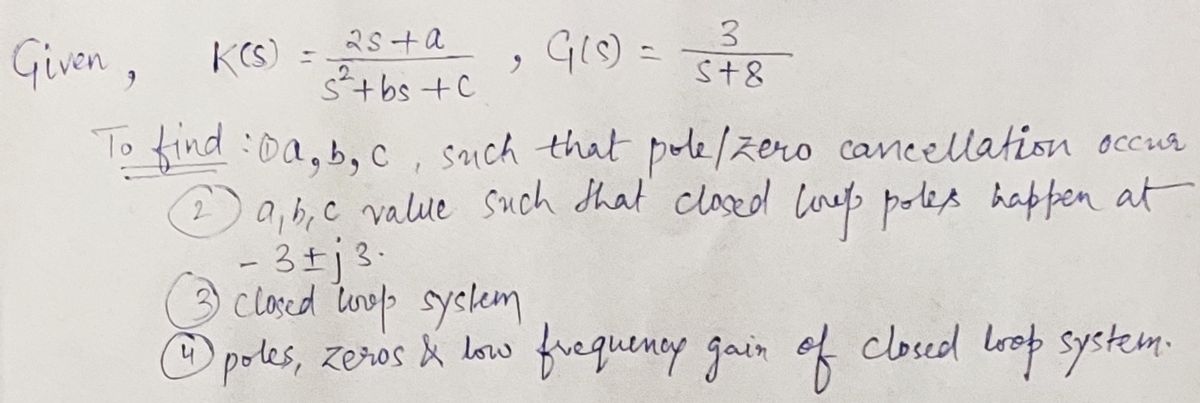4. In this problem, the plant G(s) given is in the feedback loop from Problem 3 with controller K(s). For this problem, you will choose the parameters a, b, and e of K(s) to design the controller. The goals are to use pole/zero cancellation to cancel the pole of G(s) and to set the poles of the closed loop system Ga(s) to -3+ j3. Use any method we have learned in class, but show your steps in determining K(s). As part of the problem, find the closed loop system Ga(s). Identify the poles, zeros, and low frequency gain of Ga(s) to verify your design. 2s + a 3 G(s) = 8+8 K(s) = %3! 2+ bs +e
4. In this problem, the plant G(s) given is in the feedback loop from Problem 3 with controller K(s). For this problem, you will choose the parameters a, b, and e of K(s) to design the controller. The goals are to use pole/zero cancellation to cancel the pole of G(s) and to set the poles of the closed loop system Ga(s) to -3+ j3. Use any method we have learned in class, but show your steps in determining K(s). As part of the problem, find the closed loop system Ga(s). Identify the poles, zeros, and low frequency gain of Ga(s) to verify your design. 2s + a 3 G(s) = 8+8 K(s) = %3! 2+ bs +e
Introductory Circuit Analysis (13th Edition)
13th Edition
ISBN:9780133923605
Author:Robert L. Boylestad
Publisher:Robert L. Boylestad
Chapter1: Introduction
Section: Chapter Questions
Problem 1P: Visit your local library (at school or home) and describe the extent to which it provides literature...
Related questions
Question
100%

Transcribed Image Text:4. In this problem, the plant G(s) given is in the feedback loop from Problem 3 with controller K(s). For
this problem, you will choose the parameters a, b, and c of K(s) to design the controller. The goals are to
use pole/zero cancellation to cancel the pole of G(s) and to set the poles of the closed loop system Ga(s)
to -3+ j3. Use any method we have learned in class, but show your steps in determining K(s). As part
of the problem, find the closed loop system Ga(s). Identify the poles, zeros, and low frequency gain of
Ga(s) to verify your design.
2s + a
K(s) =
3
G(s) =
%3!
2+ bs + e
8+8
Expert Solution
Step 1

Trending now
This is a popular solution!
Step by step
Solved in 3 steps with 3 images

Knowledge Booster
Learn more about
Need a deep-dive on the concept behind this application? Look no further. Learn more about this topic, electrical-engineering and related others by exploring similar questions and additional content below.Recommended textbooks for you

Introductory Circuit Analysis (13th Edition)
Electrical Engineering
ISBN:
9780133923605
Author:
Robert L. Boylestad
Publisher:
PEARSON

Delmar's Standard Textbook Of Electricity
Electrical Engineering
ISBN:
9781337900348
Author:
Stephen L. Herman
Publisher:
Cengage Learning

Programmable Logic Controllers
Electrical Engineering
ISBN:
9780073373843
Author:
Frank D. Petruzella
Publisher:
McGraw-Hill Education

Introductory Circuit Analysis (13th Edition)
Electrical Engineering
ISBN:
9780133923605
Author:
Robert L. Boylestad
Publisher:
PEARSON

Delmar's Standard Textbook Of Electricity
Electrical Engineering
ISBN:
9781337900348
Author:
Stephen L. Herman
Publisher:
Cengage Learning

Programmable Logic Controllers
Electrical Engineering
ISBN:
9780073373843
Author:
Frank D. Petruzella
Publisher:
McGraw-Hill Education

Fundamentals of Electric Circuits
Electrical Engineering
ISBN:
9780078028229
Author:
Charles K Alexander, Matthew Sadiku
Publisher:
McGraw-Hill Education

Electric Circuits. (11th Edition)
Electrical Engineering
ISBN:
9780134746968
Author:
James W. Nilsson, Susan Riedel
Publisher:
PEARSON

Engineering Electromagnetics
Electrical Engineering
ISBN:
9780078028151
Author:
Hayt, William H. (william Hart), Jr, BUCK, John A.
Publisher:
Mcgraw-hill Education,